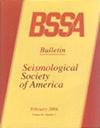Rapid Estimation of Single-Station Earthquake Magnitudes with Machine Learning on a Global Scale
IF 2.9
3区 地球科学
Q2 GEOCHEMISTRY & GEOPHYSICS
引用次数: 0
Abstract
The foundation of earthquake monitoring is the ability to rapidly detect, locate, and estimate the size of seismic sources. Earthquake magnitudes are particularly difficult to rapidly characterize because magnitude types are only applicable to specific magnitude ranges, and location errors propagate to substantial magnitude errors. We developed a method for rapid estimation of single-station earthquake magnitudes using raw three-component P waveforms observed at local to teleseismic distances, independent of prior size or location information. We used the MagNet regression model architecture (Mousavi and Beroza, 2020b), which combines convolutional and recurrent neural networks. We trained our model using ∼2.4 million P-phase arrivals labeled by the authoritative magnitude assigned by the U.S. Geological Survey. We tested input data parameters (e.g., window length) that could affect the performance of our model in near-real-time monitoring applications. At the longest waveform window length of 114 s, our model (Artificial Intelligence Magnitude [AIMag]) is accurate (median estimated magnitude within ±0.5 magnitude units from catalog magnitude) between M 2.3 and 7.6. However, magnitudes above M ∼7 are more underestimated as true magnitude increases. As the windows are shortened down to 1 s, the point at which higher magnitudes begin to be underestimated moves toward lower magnitudes, and the degree of underestimation increases. The over and underestimation of magnitudes for the smallest and largest earthquakes, respectively, are potentially related to the limited number of events in these ranges within the training data, as well as magnitude saturation effects related to not capturing the full source time function of large earthquakes. Importantly, AIMag can determine earthquake magnitudes with individual stations’ waveforms without instrument response correction or knowledge of an earthquake’s source-station distance. This work may enable monitoring agencies to more rapidly recognize large, potentially tsunamigenic global earthquakes from few stations, allowing for faster event processing and reporting. This is critical for timely warnings for seismic-related hazards.利用机器学习快速估算全球单站地震震级
地震监测的基础是快速探测、定位和估算震源规模的能力。地震震级尤其难以快速确定,因为震级类型只适用于特定的震级范围,而且定位误差会传播到很大的震级误差。我们开发了一种方法,利用在本地到远震距离观测到的原始三分量 P 波形,快速估算单个台站的地震震级,而不受先前震级大小或位置信息的影响。我们使用了 MagNet 回归模型架构(Mousavi 和 Beroza,2020b),该架构结合了卷积神经网络和递归神经网络。我们使用由美国地质调查局分配的权威震级标注的 240 万个 P 相到达数据对模型进行了训练。我们测试了可能影响模型在近实时监测应用中性能的输入数据参数(如窗口长度)。在最长波形窗口长度为 114 秒时,我们的模型(人工智能震级 [AIMag])在 M 2.3 至 7.6 之间是准确的(估计震级中位数与目录震级的误差在 ±0.5 个震级单位以内)。然而,随着真实星等的增加,M ∼7以上的星等被低估得更多。当窗口缩短到 1 秒时,开始低估较高星等的点向较低星等移动,低估程度也随之增加。最小地震和最大地震的震级分别被高估和低估,可能与训练数据中这些范围内的事件数量有限有关,也可能与没有捕捉到大地震的全部震源时间函数有关的震级饱和效应有关。重要的是,AIMag 可以通过单个台站的波形确定地震震级,而无需仪器响应校正或了解地震的震源-台站距离。这项工作可使监测机构更快地从少数几个台站识别出可能引发海啸的全球大地震,从而更快地处理和报告事件。这对于及时预警地震相关灾害至关重要。
本文章由计算机程序翻译,如有差异,请以英文原文为准。
求助全文
约1分钟内获得全文
求助全文
来源期刊

Bulletin of the Seismological Society of America
地学-地球化学与地球物理
CiteScore
5.80
自引率
13.30%
发文量
140
审稿时长
3 months
期刊介绍:
The Bulletin of the Seismological Society of America, commonly referred to as BSSA, (ISSN 0037-1106) is the premier journal of advanced research in earthquake seismology and related disciplines. It first appeared in 1911 and became a bimonthly in 1963. Each issue is composed of scientific papers on the various aspects of seismology, including investigation of specific earthquakes, theoretical and observational studies of seismic waves, inverse methods for determining the structure of the Earth or the dynamics of the earthquake source, seismometry, earthquake hazard and risk estimation, seismotectonics, and earthquake engineering. Special issues focus on important earthquakes or rapidly changing topics in seismology. BSSA is published by the Seismological Society of America.
 求助内容:
求助内容: 应助结果提醒方式:
应助结果提醒方式:


